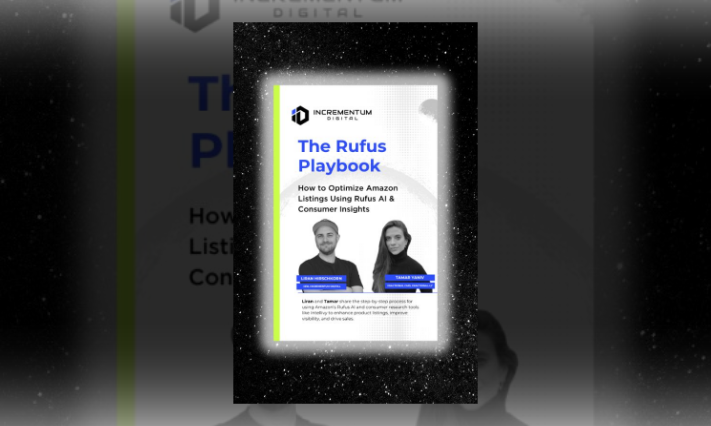eCommerce News
2025 Predictions: How Amazon’s New AI Tools Will Redefine E-Commerce (Pros, Cons, and Key Takeaways for Brands)

Will Amazon’s new ad tools boost your brand—or kill it? Amazon’s latest wave of advertising tools, unveiled at Unboxed 2024, promises to transform how brands connect with their audiences. From AI-driven creative solutions to expanded global ad reach, these innovations are all about making campaigns more efficient, personalized, and strategically integrated. Whether you’re a small business looking to scale or a global player fine-tuning your strategy, these tools aim to boost agility, creativity, and performance. But with these upgrades come real challenges. Data overload, localization hurdles, and balancing automation with creativity could trip up brands that aren’t ready. In this blog post, we’ll break down the benefits and potential pitfalls of these new tools, and show how brands—big and small—can navigate the changing landscape to thrive.

Learn How to Make Listings That Convert in 2025!
Read our step-by-step guide on how to optimize your listings using Rufus AI insights. Sign up for our newsletter and get your copy for free!
Show me howPrediction 1: Hyper-Personalization Will Become the New Standard for Advertising
The Pros
Enhanced targeting tools and AI-driven creatives—like Amazon’s AI Creative Studio, Video Generator, and Audio Generator—are setting the stage for hyper-personalized campaigns to become the norm. Brands can now leverage these tools to create highly specific, tailored ads, product recommendations, and emails that resonate on an individual level. With these AI solutions, advertisers can quickly produce dynamic content that adapts to real-time customer behavior, ensuring that every touchpoint feels personalized and relevant.
This level of personalization boosts engagement and leads to higher conversion rates because customers feel understood and valued. Real-time data plays a crucial role here, enabling brands to dynamically adjust their content based on user behavior. Imagine personalized ads that change based on what customers have just browsed, or product recommendations that feel custom-made for their preferences.
The Cons
The shift toward hyper-personalization isn’t without its challenges. Producing tailored content for a wide range of audiences can be costly and complex, especially for smaller brands with limited budgets. It requires an investment in technology, creative assets, and data analysis, which not all companies can manage effectively.
Privacy is another major concern—consumers are increasingly cautious about how their data is used, and brands need to be transparent about data collection and usage to maintain trust.
Lastly, there’s the risk of ad fatigue. Seeing repetitive, overly targeted messages can lead to customer burnout, causing them to disengage. Brands need to find the right balance to keep their content fresh and engaging without overwhelming their audience.
Key Takeaways for Brands:
- Invest in scalable AI tools that help you personalize efficiently. These can streamline content creation, allowing you to scale your efforts without compromising on quality.
- Prioritize transparency. Make sure your privacy policies are clear and give customers control over their data. This builds trust and ensures compliance.
- Diversify your content. Avoid bombarding users with the same message across channels. Experiment with different formats, creatives, and messaging to keep engagement high and prevent ad fatigue.
Prediction 2: Automation Will Revolutionize Ad Strategies
The Pros
The rise of no-code tools and AI—like Amazon’s Performance+—is transforming how brands approach advertising. Such tools will allow businesses to streamline processes like audience segmentation, bid adjustments, and content updates without needing constant manual input. Performance+ automates audience building and optimization, while Ads Data Manager integrates data seamlessly, helping brands make quick adjustments and improve campaign performance.
This efficiency frees up resources, enabling marketing teams to shift their focus to strategy and creative innovation instead of getting bogged down by repetitive tasks. Plus, automation makes it easier to test, optimize, and scale campaigns, reducing time to market and helping brands stay ahead of the curve.
The Cons
The convenience of automation can have its downsides. Automated ad creation may lack the nuance and emotional appeal of human-crafted content, leading to ads that feel generic or impersonal. Heavy reliance on automation can also stifle creativity, resulting in repetitive outputs that fail to stand out.
Additionally, while automation provides valuable insights, it can also lead to data overload. Without a clear strategy for analyzing and prioritizing these insights, brands may struggle to focus on what truly drives campaign success, leading to missed opportunities or ineffective campaigns.
Key Takeaways for Brands:
- Leverage automation for efficiency, especially for repetitive tasks, but ensure that your creative work retains a human touch. This blend will help maintain authenticity and emotional appeal.
- Balance efficiency with creativity by incorporating unique, handcrafted elements into your campaigns. Let automation handle the bulk, but use your creative team to inject originality.
- Prioritize key metrics that align with your business goals. Focus on the data points that matter most, and avoid getting distracted by excessive information that doesn’t contribute to success.
Prediction 3: Full-funnel Advertising Will Be Essential for Success Across Channels
The Pros
In 2025, full-funnel advertising will be a must-have strategy for brands aiming to guide customers seamlessly from awareness to conversion. With tools like Amazon Marketing Cloud (AMC), multi-touch attribution, and Conversion Path Reporting, brands can deliver consistent, cross-channel messaging that creates a smoother customer journey. Whether it’s through social media, search ads, or email, every interaction works together to move the customer closer to a purchase. A well-executed full-funnel approach ensures no touchpoint is left behind, leading to improved ROI as campaigns are optimized across all stages of the funnel. With the advancements in multi-touch attribution and AMC, brands can gain clearer insights into how different channels drive conversions, helping them allocate budgets more strategically and refine their ad spend.
The Cons
However, implementing a full-funnel strategy is not without its challenges. It requires significant resources and careful planning, which can be difficult for smaller brands with limited budgets. Coordinating consistent messaging across multiple platforms also presents a risk—if not managed well, it can lead to fragmented or confusing customer experiences.
Even with advances in attribution tools, pinpointing exactly how each channel contributes to the final conversion remains a complex task. This can make it harder for brands to measure success accurately and optimize their strategies effectively.
Key Takeaways for Brands:
- Plan for the entire customer journey. Understand how your audience moves from awareness to purchase, and ensure each stage has a clear role and strategy.
- Keep messaging consistent across all channels. While it’s important to tailor content for different platforms, the core message should remain cohesive to maintain brand clarity.
- Use multi-touch attribution to understand how different channels work together and refine your ad spend. Stay flexible and be ready to adjust based on the insights you gather.
Prediction 4: AI Creative Tools Will Dominate Ad Production, But Authenticity Will Be Key
The Pros
Creative Studio, Video Generator, and Audio Generator are revolutionizing ad production by making it faster and more efficient. With these tools, brands can quickly produce tailored ads for various platforms, enabling them to adapt content on the fly and stay agile. This speed and flexibility are crucial for responding to market trends and customer preferences. Additionally, AI can handle bulk tasks—such as generating multiple versions of a creative or adjusting formats for different channels—freeing up creative teams to focus on strategic and unique content that truly makes a brand stand out.
The Cons
The widespread use of AI-generated ads brings the risk of market saturation. As more brands lean on AI for content creation, repetitive patterns and styles may emerge, leading to ad fatigue among consumers who might start to tune out overly similar ads. There’s also the danger of losing authenticity; over-reliance on AI can dilute a brand’s unique voice, making it harder to create a memorable and engaging brand presence. To truly stand out, brands will need to strike the right balance between AI efficiency and human creativity, ensuring that campaigns remain fresh and authentic.
Key Takeaways for Brands:
- Use AI tools for efficiency, but don’t sacrifice originality. Maintain your brand’s distinct voice and personality, even in automated content.
- Rotate and refresh your content regularly to prevent ad fatigue. Keep audiences engaged by varying formats, visuals, and messages.
- Combine the speed of AI with the creativity of your team. Let AI handle bulk production tasks while your creative teams focus on developing standout ideas that capture attention.
Prediction 5: Global Expansion of Prime Video Ads Will Open Up New Markets, But Localization Will Be Key
The Pros
Amazon’s expansion of Prime Video ads to countries like Brazil, India, Japan, the Netherlands, and New Zealand in 2025 offers brands a unique opportunity to reach diverse, high-intent audiences around the world. This global reach means brands can scale their campaigns beyond local borders, tapping into new markets with a single strategy. The ability to engage viewers during major events—like NBA games streamed on Prime Video—adds even more value, allowing brands to build awareness through popular, high-impact content that resonates across regions. For companies looking to grow internationally, this opens up new avenues for scaling campaigns and driving brand growth across multiple regions.
The Cons
However, the challenges of managing global campaigns shouldn’t be underestimated. Successfully navigating different languages, cultural nuances, and market preferences requires careful planning and coordination. Without proper localization, brands risk delivering ineffective messaging that fails to connect with regional audiences.
Generic, one-size-fits-all content may not resonate across diverse markets, and adapting campaigns for each locale can increase complexity and costs. Effective global strategies will depend on a brand’s ability to tailor content to specific audiences, ensuring that messages feel relevant and authentic wherever they are seen.
Key Takeaways for Brands:
- Tailor content for each market. Localization is essential to ensure that your ads resonate with diverse audiences across the globe.
- Leverage global ad placements to reach new audiences, but make sure campaigns are aligned with local interests to maximize engagement.
- Plan for localization early. Consider language, cultural references, and region-specific preferences during the campaign development phase to streamline execution and avoid costly last-minute changes.
Conclusion
2025 is set to bring a whole new playbook for brands. With Amazon’s latest tools, you can expect more personalization, faster automation, smarter full-funnel strategies, and a global reach that’s never been easier to tap into. But these upgrades aren’t without their challenges—like managing data overload, avoiding cookie-cutter content, and making sure your message hits home in every market.
The key? Balance automation with creativity, use data smartly and plan for a global game. Start fine-tuning your strategy now so you’re ready to harness these tools and keep your edge. The future’s coming fast—time to get ahead of it!
LET’S DISCOVER WHAT’S POSSIBLE FOR YOUR BRAND
We’re here to listen and uncover opportunities tailored to your unique goals.
Fill out the form to get started, and you’ll walk away with real insights and actionable recommendations—whether we work together or not.
- HANDS-ON LEADERSHIP
- AWARD-WINNING PARTNERSHIPS
- CUSTOM-BUILT SOLUTIONS




